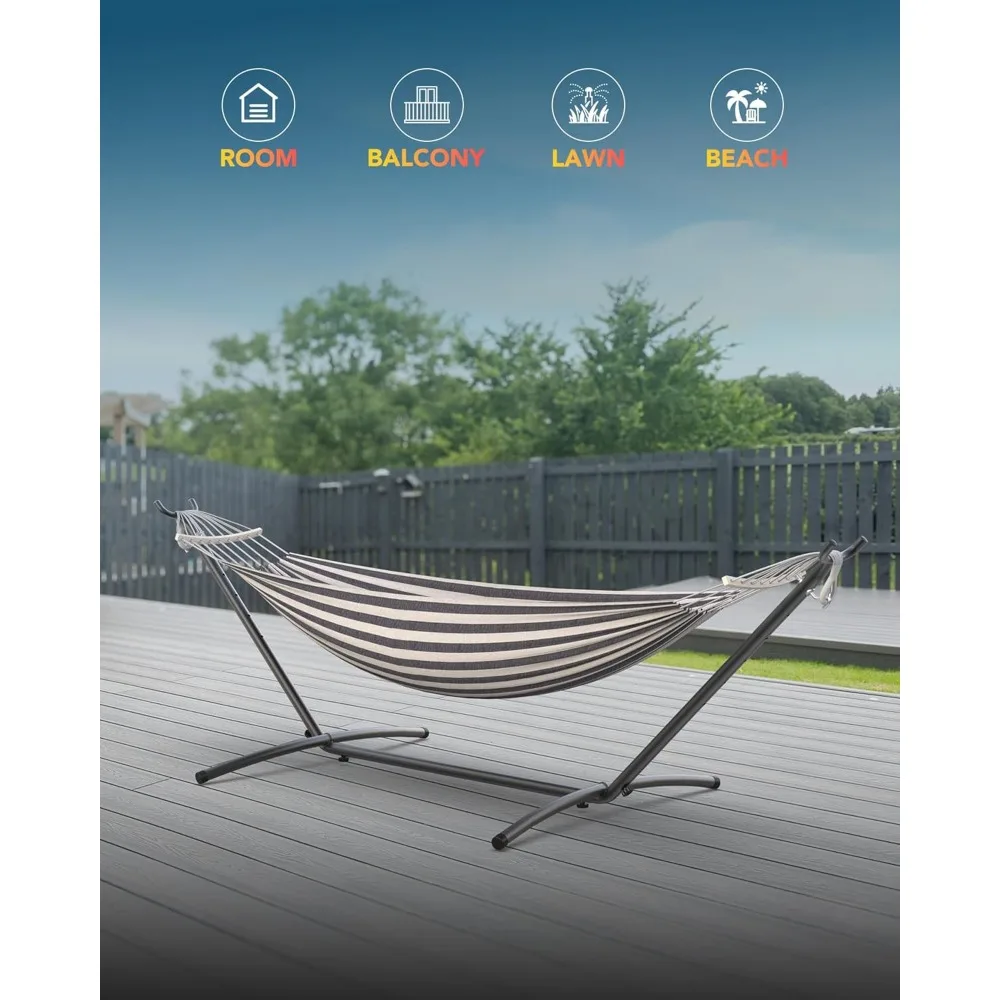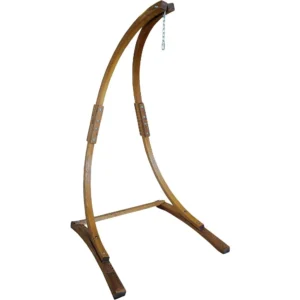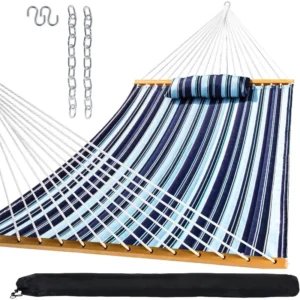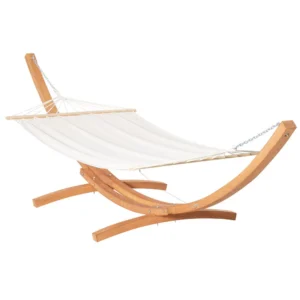Why Hammock Weight Capacity Matters for Safe Relaxation
Understanding hammock weight capacity isn’t just about technical specifications—it’s about your safety and enjoyment. The weight capacity of a hammock determines how much weight it can safely hold without risking failure or damage, making it one of the most critical factors to consider when selecting or using any hammock.
When you ignore proper hammock weight support guide, you expose yourself to three significant risks:
- Safety hazards: Hammock failure can lead to sudden falls and potential injuries ranging from minor bruises to more serious injuries depending on height and landing surface
- Premature wear: Even if a hammock doesn’t fail immediately, exceeding its weight capacity consistently causes faster deterioration of materials and connection points
- Compromised comfort: Hammocks supporting weights near or above their capacity won’t provide the optimal lounging experience—excessive sagging, instability, and discomfort become common
Most accidents related to hammocks occur not because of manufacturing defects but because users underestimate the importance of weight limits. According to injury prevention data, falls from hammocks rank among the most common outdoor relaxation accidents, with many directly attributable to weight capacity issues.
Throughout this guide, we’ll explore everything you need to know about hammock weight capacities—from understanding manufacturer ratings and comparing different hammock types to selecting the perfect option for your needs and maintaining it properly for years of safe relaxation.
Understanding Weight Capacity: Static vs. Dynamic Load
When manufacturers specify a “maximum weight capacity” for hammocks, they’re typically referring to static load—the weight the hammock can hold when occupants are lying still. However, this doesn’t tell the whole story of what your hammock can actually support in real-world use.
The distinction between static and dynamic loads is critical for understanding hammock load capacity:
Static load refers to the stationary weight applied to a hammock when you’re lying motionless. This is the figure most commonly cited in product specifications and represents ideal conditions with evenly distributed weight.
Dynamic load, in contrast, includes all forces generated by movement—sitting down quickly, shifting positions, swinging, or bouncing. These actions can multiply the effective force applied to your hammock significantly.
| Load Type | Description | Multiplication Factor | Example |
|---|---|---|---|
| Static Load | Weight at rest | 1× | 200 lbs person lying still = 200 lbs force |
| Minor Dynamic | Gentle shifting positions | 1.5-2× | 200 lbs person shifting = 300-400 lbs force |
| Moderate Dynamic | Sitting down normally | 2-3× | 200 lbs person sitting down = 400-600 lbs force |
| High Dynamic | Plopping down/bouncing | 3-5× | 200 lbs person plopping down = 600-1000 lbs force |
Manufacturers typically determine weight limits through a combination of material strength calculations and physical testing. Test protocols usually involve gradually increasing static loads until failure points are identified, then applying safety margins. Some premium manufacturers also conduct dynamic load testing, though this isn’t universal across the industry.
This distinction explains why a hammock rated for 400 lbs static capacity might still fail when a 250 lbs person sits down too quickly—the dynamic force momentarily exceeds the hammock’s limits. For safety and longevity, consider the dynamic forces you’ll generate during normal use.
For those requiring higher weight capacities, heavy-duty hammock sets incorporate reinforced materials and construction techniques specifically designed to handle greater static and dynamic loads safely.
Hammock Weight Capacities by Type: Complete Comparison
Different hammock designs serve different purposes and consequently offer varying weight capacities. Understanding these differences is essential when selecting the right hammock for your needs and body type. The table below provides a comprehensive overview of single vs double hammock weight limits and other hammock styles:
| Hammock Type | Typical Weight Capacity | Material Considerations | Ideal Use Case | Special Notes |
|---|---|---|---|---|
| Single Hammock | 250-400 lbs (113-181 kg) | Usually lightweight nylon or polyester | Solo relaxation, backpacking | Most portable option |
| Double Hammock | 400-500 lbs (181-227 kg) | Reinforced nylon/polyester, higher denier | Couples, solo users wanting extra space | Wider design, more fabric |
| Camping Hammock | 300-450 lbs (136-204 kg) | Ripstop nylon, weather-resistant materials | Outdoor adventures, overnight sleeping | Often includes integrated bug nets/rain flies |
| Spreader Bar Hammock | 250-450 lbs (113-204 kg) | Cotton, polyester, or Sunbrella fabric | Backyard, patio, deck use | Less stable than gathered end designs |
| Hammock Chair | 200-350 lbs (91-159 kg) | Various fabrics, reinforced suspension | Small spaces, reading nooks | More concentrated weight distribution |
| Heavy-Duty Hammock | 450-800+ lbs (204-363+ kg) | Reinforced seams, thicker materials | Multiple users, larger individuals | Premium construction, higher price point |
| Brazilian Hammock | 300-450 lbs (136-204 kg) | Tightly woven cotton | Traditional lounging | Durable but requires protection from elements |
| Aerial Yoga Hammock | 300-600 lbs (136-272 kg) | Specialized silk or nylon blends | Exercise, stretching | Designed for movement, special hardware needed |
Many users find that double two-person hammock sets provide an ideal balance of capacity and comfort even for solo use, offering extra space to spread out while providing higher weight limits.
It’s important to note that these figures represent industry averages—specific products may vary. Always check the manufacturer’s stated weight limit for your particular hammock rather than relying on these general guidelines. Also remember that these ratings typically refer to static load capacity, not dynamic forces generated by movement.
When selecting a hammock, consider not just your current weight but also potential future sharing with partners, children, or pets. Adding a 50-100 pound buffer to your actual needs provides both safety margin and flexibility for different usage scenarios.
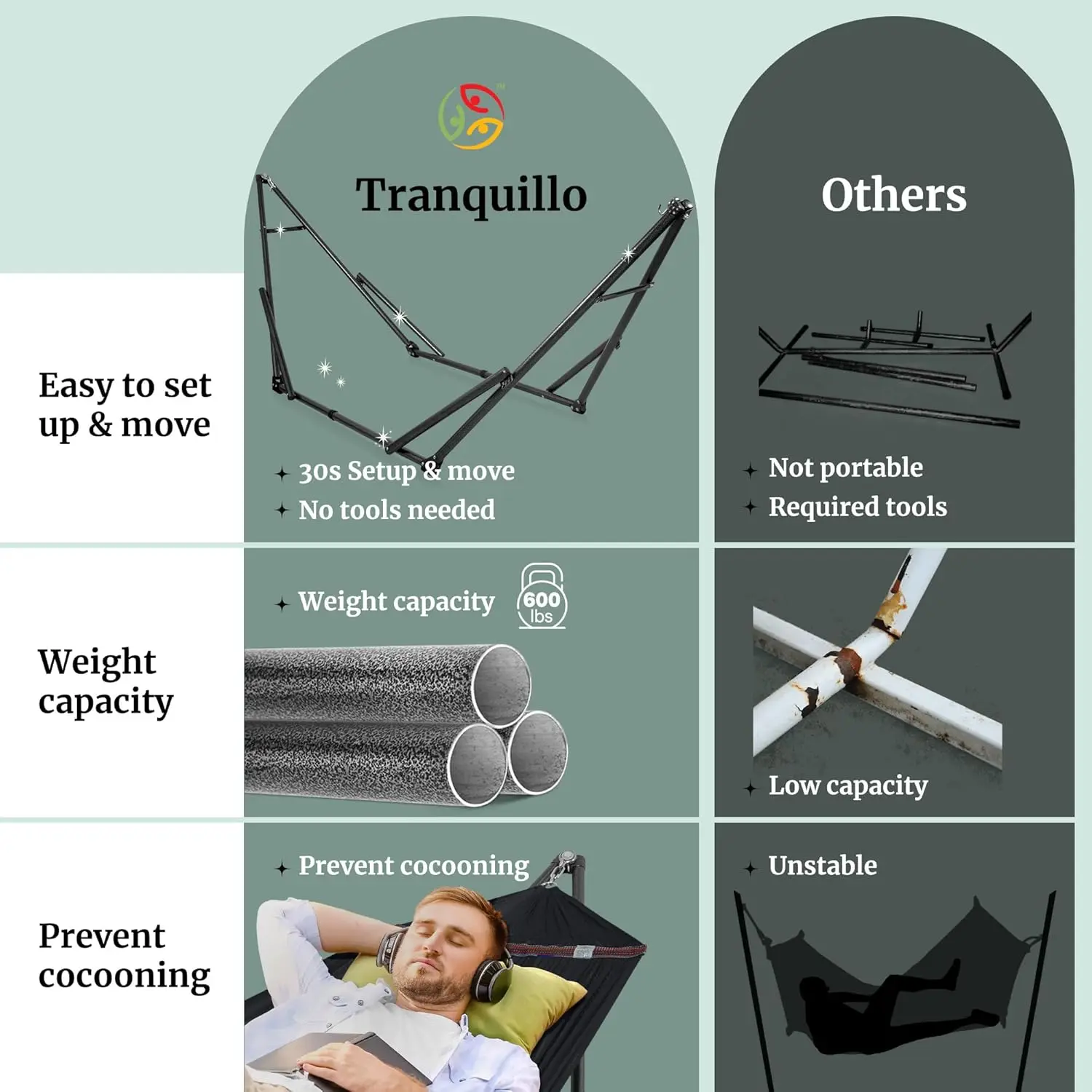
Critical Factors Influencing Hammock Strength and Support
The actual strength and support capabilities of a hammock depend on much more than just its advertised weight capacity. Understanding how hammock material affects weight capacity can help you make more informed choices and better assess your hammock’s true capabilities.
Material Considerations
The fabric used in hammock construction plays a crucial role in determining strength:
- Nylon: Excellent strength-to-weight ratio, common in camping and travel hammocks
- Higher denier ratings (200D-70D) indicate stronger, thicker fabrics
Ripstop varieties prevent small tears from spreading
Polyester: Less stretch than nylon, maintains shape better under load
- Typically found in 200-600 denier weights
Superior UV resistance compared to nylon or cotton
Cotton: Common in traditional and decorative hammocks
- Comfortable but generally less strong than synthetic options
Natural fibers may deteriorate faster with exposure to elements
Blends and Specialty Fabrics: Often combine comfort with durability
- Some premium hammocks use proprietary weaves or treatments
- Sunbrella and other outdoor-specific fabrics offer both strength and weather resistance
Construction Elements
How a hammock is put together matters just as much as what it’s made from:
- Stitching techniques: Triple-stitched seams can withstand significantly more weight than single-stitched versions
- Reinforced end points: Extra layers of fabric or bar-tacking at suspension points prevent the most common failure locations
- Design structure: Gathered-end hammocks typically distribute weight more evenly than spreader bar models
Suspension Systems
The suspension system must be as strong as—or stronger than—the hammock itself:
- Straps and ropes: Must match or exceed hammock capacity
- Polyester webbing straps typically rated for 400-1500 lbs breaking strength
- Thickness correlates with strength (thicker = stronger)
- Carabiners and hardware: Look for weight ratings 2-3× your body weight
- Connection points: Often the weakest link in the system
Hammock Stands
Camping hammocks with stands require special attention to weight capacity considerations:
- Stand materials: Steel stands typically support more weight than aluminum or wood
- Design engineering: Weight capacity depends on geometry and load distribution
- Stability factors: Width of base, connection points, and cross-bracing all affect safe capacity
- Independent rating: Stands have their own weight limits that may differ from the hammock itself
Remember that a hammock system is only as strong as its weakest component. A 500-pound capacity hammock attached to hardware rated for only 300 pounds creates a system with an effective 300-pound limit.
Dangers of Exceeding Weight Limits: What’s at Risk
When you ignore the safe hammock weight limits, you’re not just risking minor inconvenience—you’re potentially setting yourself up for serious consequences. Understanding these risks can help emphasize why adherence to weight guidelines isn’t optional.
Potential Injuries
Hammock failures often happen suddenly and without warning:
- Fall-related injuries: The most immediate danger is falling from height, which can result in:
- Bruises, sprains, and cuts from impact
- More serious injuries like fractures or head trauma depending on fall height
Compounded injuries from landing on hard or sharp objects below
Severity factors: Several elements influence how dangerous a hammock failure might be:
- Height above ground (higher = more dangerous)
- Surface below (concrete vs. grass vs. water)
- Position and orientation during fall
- Ability to react/brace for impact
Equipment Damage
Beyond personal injury, exceeding weight capacity damages your equipment:
- Immediate failure points:
- Fabric tears, especially at stress points
- Broken suspension ropes or straps
- Bent or broken carabiners or hooks
Collapsed or twisted stands
Anchor point damage:
- Tree bark stripping or branch breakage
- Wall mount pullout or structural damage
- Damaged posts or other mounting hardware
Spreader bar hammock sets are particularly vulnerable to certain types of damage when overloaded, as their rigid components can bend or break rather than simply stretching like fabric-only designs.
Long-term Degradation
Even if your hammock doesn’t fail immediately, exceeding its weight capacity causes cumulative damage:
- Gradual fiber stretching weakens overall strength
- Stitching loosens over time, especially at critical junctions
- Small tears develop that may go unnoticed until catastrophic failure
- Suspension system components experience metal fatigue or rope fraying
Comfort and Stability Issues
Before outright failure, overloaded hammocks become increasingly uncomfortable and unstable:
- Excessive sagging creates poor ergonomic support
- Difficulty getting in and out safely
- Increased side-to-side instability raises tipping risk
- Uncomfortable pressure points where fabric stretches too much
Understanding these risks highlights why choosing the appropriate weight capacity isn’t just about following rules—it’s about ensuring your safety and comfort while preserving your investment in quality hammock equipment.
Locating Your Hammock’s Weight Capacity Information
Finding accurate weight capacity information is an essential first step in ensuring safe hammock use. Manufacturers provide this critical data in several locations, though some sources are more reliable than others.
Primary Information Sources
Most new hammocks clearly display their weight capacity in at least one of these places:
- Product packaging: Weight limits are typically prominently displayed on the box or packaging materials
- Attached tags or labels: Look for permanently attached tags with safety information
- Instruction manuals: Detailed specifications are usually included in any documentation
- Manufacturer websites: Product pages almost always list weight capacity in specifications
When researching how much weight a hammock can hold, the manufacturer’s directly stated limit should be considered the definitive answer.
For Unlabeled or Older Hammocks
If you have a hammock without clear weight capacity information:
- Contact the manufacturer: If you know the brand, reach out to their customer service
- Look for model numbers: Even partial information can help identify specifications
- Inspect construction: While not ideal, examining stitching quality, fabric thickness, and suspension components can provide clues
- Consider replacement: For safety’s sake, replacing an unlabeled hammock may be wisest if you can’t determine its capacity
Warning Against Assumptions
It’s dangerous to guess weight capacity based on:
- Similar-looking hammocks from different brands
- General type (e.g., assuming all rope hammocks hold the same weight)
- Price point (though higher-quality hammocks often have higher capacity, this isn’t guaranteed)
- Visual inspection alone (internal construction matters as much as visible elements)
What if Information Conflicts?
Occasionally you might find different weight limits listed in different places for the same hammock. When this happens:
- Always use the lowest stated figure for safety
- Contact the manufacturer for clarification
- Remember that capacity may differ between static and dynamic loads
Remember that knowing your hammock’s true weight capacity is fundamental to using it safely. Never use a hammock if you cannot determine how much weight it’s designed to hold.
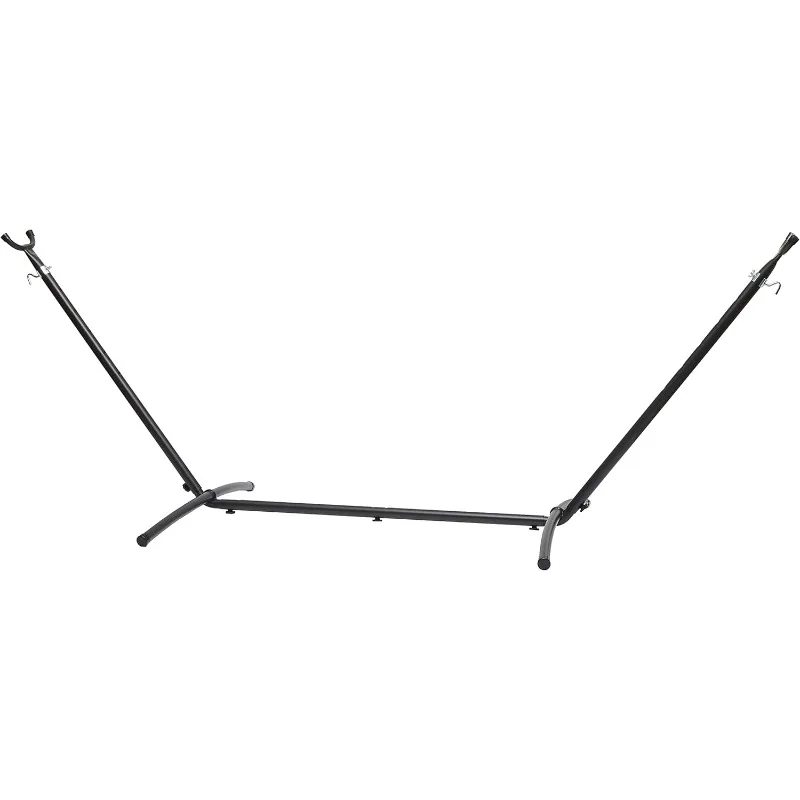
Selecting the Right Hammock: Weight Capacity Guidelines
Choosing a hammock with appropriate weight capacity requires careful consideration of your specific needs and usage patterns. Following these guidelines will help ensure both safety and satisfaction with your purchase.
Calculate Your Required Capacity
Use this simple formula to determine your minimum needed capacity:
Required capacity = User weight + Gear weight + Safety margin
For example:
* 180 lbs person + 20 lbs of gear + 50 lbs safety margin = 250 lbs minimum capacity
For multiple users, add all weights together:
* 180 lbs person + 140 lbs person + 30 lbs gear + 50 lbs safety margin = 400 lbs minimum capacity
Don’t forget to account for pets if they’ll be joining you!
The Buffer Zone Approach
The hammocks for heavier individuals guide recommends always selecting a hammock with a weight capacity that exceeds your calculated minimum by at least 50-100 pounds. This buffer provides:
- Safety margin for unexpected dynamic loads
- Accommodation for weight fluctuations over time
- Reduced long-term stress on materials
- Greater flexibility for different users or situations
Single vs. Double Considerations
Even solo users should consider the benefits of portable hammocks with stands in double sizes:
Single Hammocks:
* Typically rated for 250-400 lbs
* More compact and lightweight
* Often less expensive
* Ideal for minimalist backpacking
Double Hammocks:
* Typically rated for 400-500+ lbs
* Provide more space to spread out
* Accommodate occasional second users
* Allow diagonal positioning for flatter lay
Future-Proofing Your Selection
When making your selection, consider:
- Will friends or family likely use this hammock?
- Might you want to share the hammock occasionally?
- How long do you expect the hammock to last?
- Will usage patterns change over time?
Heavy-duty stand materials matter just as much as the hammock itself. Ensure your stand matches or exceeds your hammock’s weight rating.
Decision Factors Beyond Weight
While weight capacity is crucial, also consider:
- Comfort features (fabric type, dimensions)
- Intended use location (indoor, backyard, camping)
- Portability needs
- Weather resistance
- Additional features (bug nets, rain flies)
By carefully calculating your needs and selecting a hammock with appropriate weight capacity plus a buffer, you’ll ensure both safety and longevity for your hammocking experience.
Verifying Hammock Weight Capacity: Can It Be Tested?
Many hammock owners wonder if they can—or should—test their hammock’s weight capacity themselves. Understanding how weight ratings are established and verified can help answer this question.
How Manufacturers Determine Capacity
Reputable hammock manufacturers employ various testing methods to establish weight limits:
- Static load testing: Gradually increasing weight until failure or significant deformation occurs
- Cycle testing: Repeatedly loading and unloading to simulate years of use
- Component testing: Evaluating individual parts (fabric, stitching, hardware) before assembly
- Field testing: Real-world testing with different users and scenarios
The published weight capacity typically includes a safety factor—meaning the hammock can usually hold more than the stated limit in perfect conditions, but this margin accounts for aging materials, less-than-perfect setup, and dynamic forces.
Why DIY Stress Testing Is Dangerous
While you might be tempted to “test” your hammock’s limits, there are several important reasons not to:
- Unpredictable failure: Hammocks often fail suddenly without warning signs
- Risk of injury: Testing to failure means someone could fall when it breaks
- Invisible damage: Even if it doesn’t break, pushing a hammock to its limits can cause microscopic damage that weakens it for future use
- Void warranty: Intentionally overloading usually voids manufacturer warranties
Understanding weight capacity on different floors can be complex and depends on various factors including installation method and building construction.
Safe First Use Approach
Instead of stress testing, take these safer steps when using a new hammock:
- Start low: Hang the hammock close to the ground (12-18 inches) for first use
- Inspect thoroughly: Check all components, stitching, and connection points
- Apply weight gradually: Sit in the center first, then slowly recline
- Watch and listen: Pay attention to any unusual stretching, creaking, or popping sounds
- Gradually increase height: Only after confirming stable performance at low height
Signs of Strain to Watch For
Be alert for these warning signs that a hammock is approaching its capacity limits:
- Unusual stretching or sagging
- Creaking or popping sounds
- Visible stress on seams or attachment points
- Difficulty maintaining stable position
- Excessive movement with minor shifts in weight
Remember that manufacturer reputation matters significantly when it comes to trusting weight ratings. Established brands with positive reviews typically provide more reliable weight capacity specifications than unknown manufacturers.
Safe Usage Practices Within Weight Limits
Even when using a hammock within its stated weight capacity, proper technique ensures maximum safety and comfort. These best practices help distribute weight appropriately and reduce unnecessary strain on your hammock system.
Proper Hanging Techniques
The way you hang your hammock significantly affects how well it supports weight:
- Choose strong anchor points: Trees should be at least 6 inches in diameter; indoor mounts need secure attachment to studs or beams
- Optimal hanging angle: Set suspension straps at approximately 30 degrees from horizontal
- Too flat (under 30°): Increases lateral force on anchors
- Too steep (over 30°): Creates unstable center of gravity
- Appropriate height: 18-24 inches above ground offers ideal balance between comfort and safety
- Even tension: Both ends should have similar tension to distribute weight properly
Understanding whether your ceiling can support a hammock is crucial for indoor setups, as installation methods must match both the hammock’s capacity and your building’s structure.
Safe Entry and Exit Methods
Proper technique for getting in and out of a hammock reduces peak forces:
- Back up to hammock: Position yourself with the hammock touching the back of your legs
- Support with hands: Place hands on the edge fabric (not suspension)
- Sit centered first: Lowering your weight to sitting position before reclining
- Distribute weight gradually: Avoid dropping or plopping your full weight suddenly
- Exit by sitting up first: Reverse the entry process, coming to sitting before standing
A-frame stand hammock sets provide particularly stable platforms for safe entry and exit compared to some other stand designs.
Responsible Movement Guidelines
Once in the hammock:
- Limit swinging motions: Gentle rocking is fine, but aggressive swinging creates dynamic forces far exceeding static weight
- Avoid jumping or bouncing: These actions can multiply effective force by 3-5 times your weight
- Distribute weight evenly: Stay centered when possible, especially in spreader bar hammocks
- For multiple occupants: Position heavier person slightly lower/center for balance
Regular Inspection Routine
Establish a habit of checking these areas before each use:
- Fabric integrity: Look for tears, thinning areas, or stretched fibers
- Seam condition: Check for loose threads or separation
- Suspension components: Inspect for fraying, wear, rust, or deformation
- Hardware condition: Verify carabiners close properly and show no cracks
- Attachment points: Ensure all knots are tight and hardware is secure
Environmental Considerations
Different conditions affect hammock performance and capacity:
- Wet materials: Most hammocks lose some strength when wet
- UV exposure: Prolonged sun exposure weakens synthetic and natural fibers
- Temperature extremes: Very cold conditions can make materials less flexible and more prone to damage
- Storage impacts: Proper storage between uses preserves strength and capacity
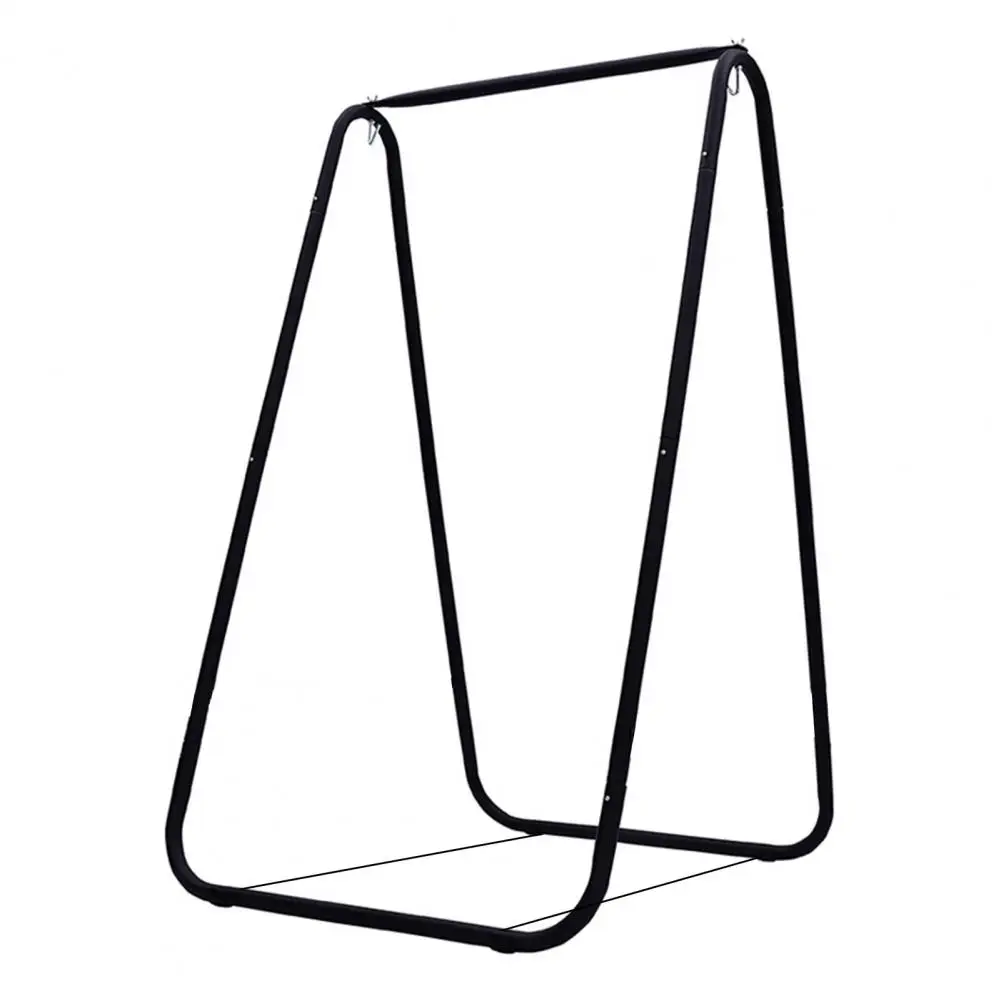
Maintaining Your Hammock for Maximum Capacity and Longevity
Proper maintenance ensures your hammock retains its weight capacity and extends its useful life. Following these care guidelines will help your hammock safely support you for years to come.
Material-Specific Cleaning Protocols
Different hammock materials require specific cleaning approaches:
Cotton Hammocks:
* Hand wash in cold water with mild soap
* Avoid bleach or harsh detergents
* Air dry completely before storing
* Clean at least seasonally or when visibly soiled
Nylon/Polyester Hammocks:
* Spot clean with mild soap and water
* For deeper cleaning, soak in lukewarm water with gentle detergent
* Rinse thoroughly to remove all soap residue
* Air dry only—never machine dry synthetic hammocks
* Clean after exposure to salt water, chlorine, or excessive dirt
Rope Hammocks:
* Spray with garden hose to remove loose debris
* Scrub gently with soft brush and mild soap solution
* Rinse thoroughly and hang to dry completely
* Apply wood oil to wooden spreader bars annually
Hammock chairs with stands often collect more dirt due to their common placement in high-traffic areas and may require more frequent cleaning.
Storage Best Practices
Proper storage significantly impacts longevity and weight capacity retention:
- Store completely dry to prevent mildew and fiber weakening
- Keep out of direct sunlight when not in use
- For fabric hammocks: loosely fold or roll rather than crumpling
- For rope hammocks: hang loose or lay flat to prevent rope distortion
- Store suspension straps separately or loosely coiled to prevent kinking
- Use breathable storage bags rather than airtight containers
Comprehensive Inspection Checklist
Perform these checks regularly, especially after periods of storage:
Every Use:
* Quick visual inspection of all components
* Check for obvious damage to fabric or ropes
* Verify hardware closure and security
Monthly:
* Detailed examination of all stitching and seams
* Inspection of attachment points for wear
* Hardware check for corrosion or deformation
Seasonally:
* Complete system assessment including all accessories
* Thorough cleaning
* Fabric stretch evaluation
* UV damage assessment
* Hardware replacement as needed
Repair vs. Replace Guidelines
Know when to repair and when replacement is safer:
Safe to Repair:
* Minor tears away from stress points
* Loose (but not separated) stitching
* Surface rust on metal components
* Cosmetic damage to wooden parts
Signs Replacement Is Needed:
* Tears near suspension points
* Failed seams or major stitch separation
* Significant fabric thinning or stretching
* Deformed carabiners or hardware
* Cracked wooden components
* Any damage that reduces capacity by more than 25%
For components that can be replaced (like carabiners or straps), always match or exceed the original weight ratings.
Dark Wood Hammock Sets, Porch Swing Chair Sets
$653.82 Select options This product has multiple variants. The options may be chosen on the product pageA-Frame Stand Hammock Sets, Swinging Hammock Chair Sets
$154.62 Select options This product has multiple variants. The options may be chosen on the product pageCamping Hammock Sets with Bug Net, Ultralight Camping Hammock Sets
$139.72 Select options This product has multiple variants. The options may be chosen on the product pageLight Wood Hammock Sets, Swinging Hammock Chair Sets
$1,359.35 Select options This product has multiple variants. The options may be chosen on the product pageClassic Wooden Stand Hammock Sets, Heavy Duty Hammock Sets
$1,061.68 Select options This product has multiple variants. The options may be chosen on the product page
Common Weight Capacity Questions Answered
Hammock users frequently have questions about weight limits. Here are straightforward answers to the most common concerns:
“What happens if I slightly exceed the weight limit?”
Exceeding a hammock’s weight capacity by even a small amount introduces risk. While you might not experience immediate failure, you’re:
- Accelerating fabric stretch and material fatigue
- Increasing stress on attachment points and hardware
- Reducing the hammock’s overall lifespan
- Eliminating the safety margin designed to protect you
The consequences aren’t always immediately visible but can lead to sudden failure later, potentially when you least expect it.
“Are manufacturer weight limits usually conservative?”
Yes and no. Reputable manufacturers typically build in a safety margin, but this margin exists for good reasons:
- To account for dynamic forces from normal movement
- To provide protection against material variations
- To compensate for aging and environmental exposure
- To cover less-than-perfect setup scenarios
This built-in buffer shouldn’t be viewed as “extra capacity” but as essential protection against real-world variables.
“Can I increase my hammock’s weight capacity?”
You cannot meaningfully increase a hammock’s inherent weight capacity after manufacturing. While you might:
- Upgrade carabiners or hardware to stronger versions
- Replace suspension straps with higher-rated alternatives
- Add support lines or stabilizers
These modifications only help if the original components were the limiting factor. The fabric, stitching, and construction will still have the same limitations, and modifying these aspects typically weakens rather than strengthens the hammock.
“Does the anchor point type affect the weight capacity?”
Absolutely. Your hammock system is only as strong as its weakest component. Strong rope hammock sets still require appropriate anchor points:
- Trees need sufficient diameter (6+ inches) and health
- Wall mounts must attach to structural elements (studs/beams)
- Stands must match or exceed hammock weight rating
- All hardware must be rated appropriately for the load
“How does a hammock stand’s weight limit relate to the hammock’s limit?”
A hammock system’s effective weight capacity is the lower of either the hammock or the stand rating. For example:
- A 450 lbs capacity hammock on a 300 lbs capacity stand = 300 lbs effective capacity
- A 300 lbs capacity hammock on a 450 lbs capacity stand = 300 lbs effective capacity
Always verify both ratings independently and use the lower figure as your guideline.
“Should I include gear weight in total capacity calculations?”
Yes. Weight capacity includes everything the hammock supports:
- Your body weight
- Clothing
- Blankets or sleeping bags
- Books or electronics
- Pets
- Drinks or snacks
- Anything else placed in the hammock
A 250 lbs person with 30 lbs of gear requires a hammock rated for at least 280 lbs plus safety margin.
“Do hammocks lose capacity over time?”
Yes. All hammocks gradually lose some of their weight capacity through:
- UV exposure weakening fibers
- Stretching of fabric and suspension components
- Wear at connection points
- Microtears and abrasion
- Environmental degradation
This is another reason to select hammocks with capacity exceeding your minimum needs and to inspect regularly for signs of wear.
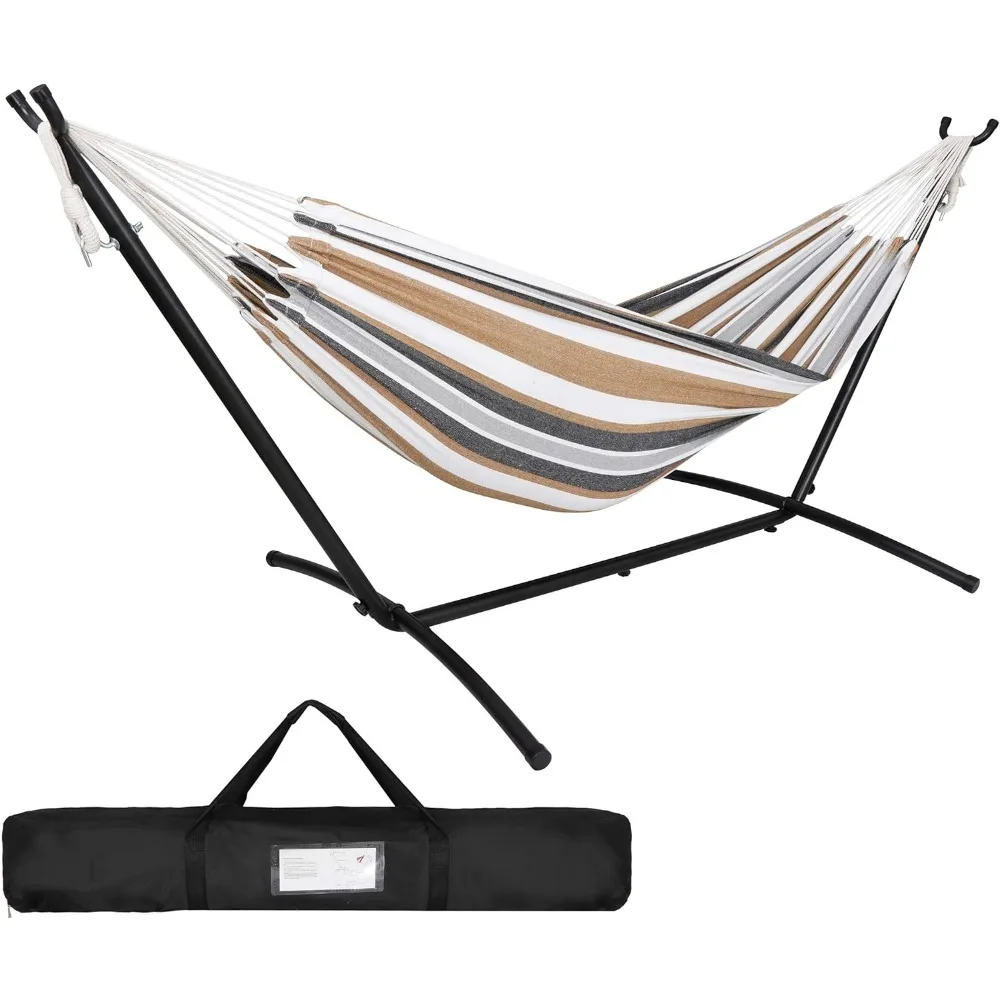
Special Considerations for Heavy-Duty and High-Capacity Options
For users requiring higher weight capacities, specialized heavy-duty hammocks offer thoughtfully engineered solutions. These premium options incorporate design features specifically created for enhanced support and durability.
Defining “Heavy-Duty” Hammocks
Heavy-duty hammocks typically offer capacities ranging from 400 to 800+ pounds (181-363+ kg) and feature several distinguishing characteristics:
- Reinforced construction: Multiple fabric layers or significantly higher denier ratings
- Enhanced stitching: Extra rows of stitching, bar tacking at stress points, and heavy-duty thread
- Premium materials: Higher tensile strength fabrics and specialized blends
- Sturdier hardware: Thicker carabiners, wider straps, and reinforced connection points
These specialized features typically result in higher price points, but the investment provides necessary safety and durability for those requiring enhanced capacity.
Specialized Design Features
Complete camping hammock systems in heavy-duty configurations often incorporate these specialized features:
- Structural reinforcement techniques:
- Double or triple-layer fabric in high-stress areas
- Webbing reinforcement along seams
- Extra bar tacking at all stress points
Specialized weight distribution panels
Hardware upgrades:
- Commercial-grade carabiners rated for 1000+ pounds
- Wider suspension straps (often 1.5-2 inches vs. standard 1 inch)
- Reinforced connection points between fabric and suspension
Higher gauge metal components in stands
Dimensional adjustments:
- Wider cut for better weight distribution
- Longer overall length to allow proper sag
- Higher fabric density to prevent stretching
Ideal Usage Scenarios
Heavy-duty hammocks are particularly valuable for:
- Multiple users: Partners wanting to share a hammock comfortably
- Users near standard limits: Those whose weight plus gear approaches or exceeds typical capacities
- Extra safety margin seekers: Users who prefer significant buffer beyond minimum requirements
- Long-term investment: Those wanting maximum durability even with regular use
Understanding two-person hammocks and stands requirements is particularly important when selecting options for shared use.
Common Misconceptions
Several myths persist about heavy-duty hammocks:
- Price always indicates capacity: While higher-capacity hammocks often cost more, price alone doesn’t guarantee higher limits; always verify specific ratings
- Weight capacity equals comfort: A high weight limit doesn’t necessarily mean better comfort; design and materials affect comfort independently
- Appearance indicates strength: Some of the strongest hammocks have simple appearances, while decorative options may have lower capacities despite elaborate looks
- All heavy-duty hammocks are bulky: Modern materials allow for high-capacity hammocks that remain reasonably compact and portable
When considering heavy-duty options, focus on verified weight ratings from reputable manufacturers rather than making assumptions based on appearance or price alone.
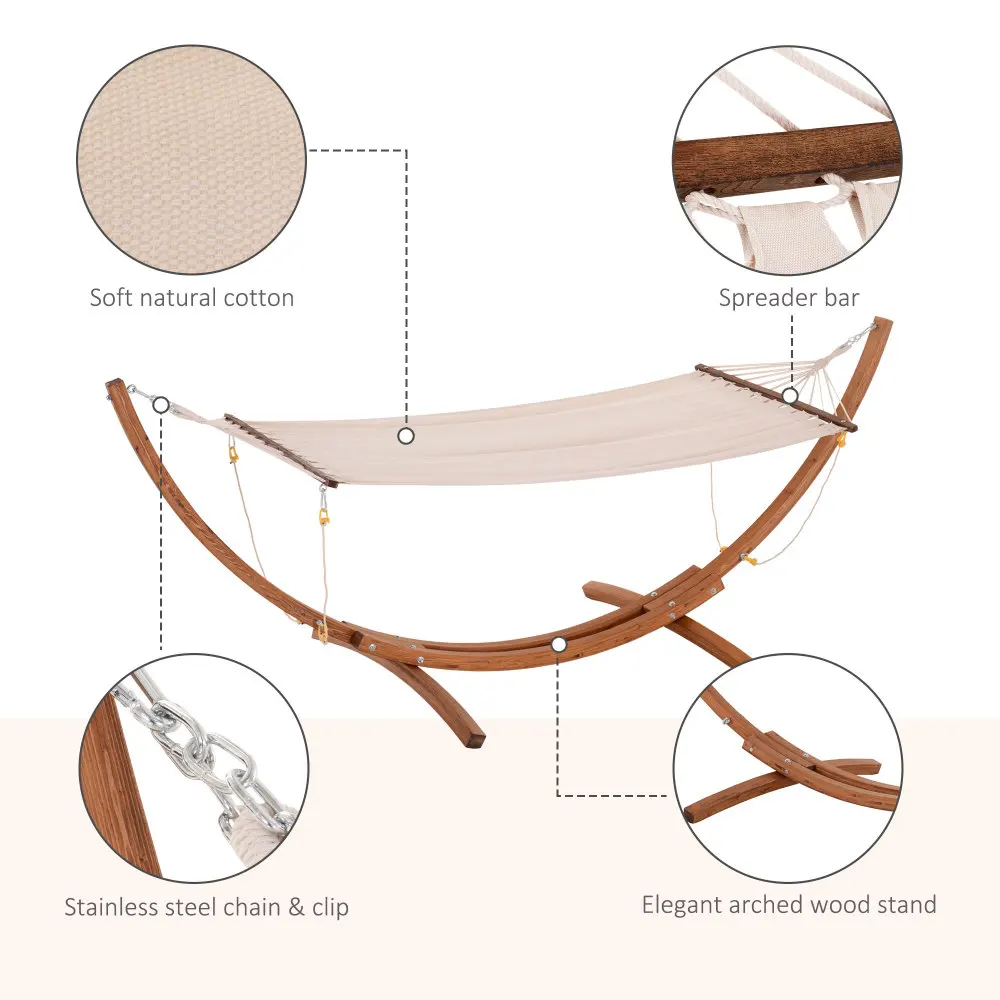
Relax with Confidence: Ensuring Safe Hammock Experiences
Understanding and respecting hammock weight capacity isn’t about limiting your relaxation—it’s about enhancing it through safety and confidence. By applying the knowledge from this guide, you can enjoy worry-free hammocking for years to come.
The key takeaways for safe hammock experiences include:
- Always verify weight capacity before using any hammock
- Understand the difference between static and dynamic loads
- Choose hammocks with appropriate capacity plus a safety margin
- Consider all factors affecting strength, not just the stated weight limit
- Maintain your hammock properly to preserve its weight-bearing capabilities
- Recognize warning signs of strain or damage
- Practice safe entry, exit, and usage techniques
Remember that proper weight capacity selection directly translates to both safety and enjoyment. A hammock that adequately supports your weight will provide better comfort, more stability, and a longer usable life than one that’s constantly stressed near its limits.
For those seeking specific solutions for different scenarios, ultralight camping hammock sets offer weight-optimized options that don’t compromise on necessary capacity and safety.
The Outside Luxe team is committed to helping customers find the perfect hammock for their specific weight requirements and usage scenarios. By prioritizing proper weight capacity in your selection process, you’re making an investment in both safety and satisfaction—allowing you to truly relax without worry each time you settle into your hammock.
Whether you’re lounging in your backyard, camping in remote wilderness, or creating an indoor retreat, the right hammock with appropriate weight capacity creates the foundation for countless hours of comfortable, safe relaxation.

